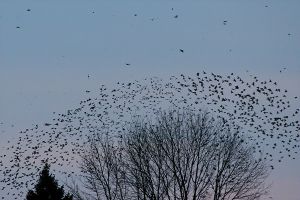 11 January 2008
11 January 2008
At rush hour last night, a river of crows flew over Fifth Avenue and perched in the trees on Wilkins. That event and last week’s robin roost prompted me to think about flocking behavior.
Flocking is a trait of social species and those whose food sources are abundant — for instance crows, gulls, starlings, and waxwings. There are several advantages in a flock.
The first is defense. It’s harder to be caught unawares if you’re in a flock with many watchers and it’s statistically quite safe. At the 100,000 robins roost we heard a pair of great-horned owls but each of those owls will catch only one bird per night. An individual robin has a 0.002% chance of becoming an owl meal.
Another advantage is the ease of finding food because so many eyes are searching. If the food source is abundant – a seed field or fruiting trees – everyone gets a meal. Obviously, flocking doesn’t work for birds like owls and hawks who catch their prey by stealth.
Flocking is fun for social species. Crows enjoy each others’ company and get smarter by being with each other. As Candace Savage said in Crows: Encounters with the Wise Guys: “Nothing is more intellectually challenging than living in a social group, surrounded by a bunch of other animals that are sharpening their wits on you.”
The most spectacular flocks are the birds who wheel in unison without an apparent leader as in the “cloud” pictured here. Not all birds fly in a tight formation like this. When it comes to flocking, starlings and shorebirds are the champs.
(photo by Tom Pawlesh)
Kate, there’s a French term for the large, swirling flocks of smaller birds that gather as they prepare to migrate, but I can’t remember it for the life of me and I was hoping to read up some. It’s similar to “troubadour” but I’m not terrific at spelling out French pronunciations. Would you happen to know the word I’m looking for? Thanks!
I don’t think I know what word you’re aiming for but here is a collection of words used to describe flocks of birds by species. Maybe the word in in this list:
http://en.wikipedia.org/wiki/List_of_collective_nouns_for_birds